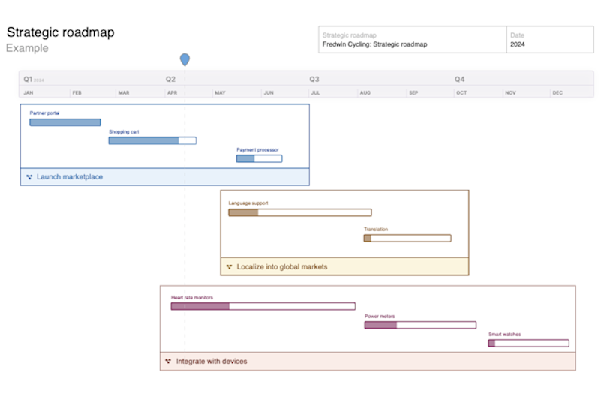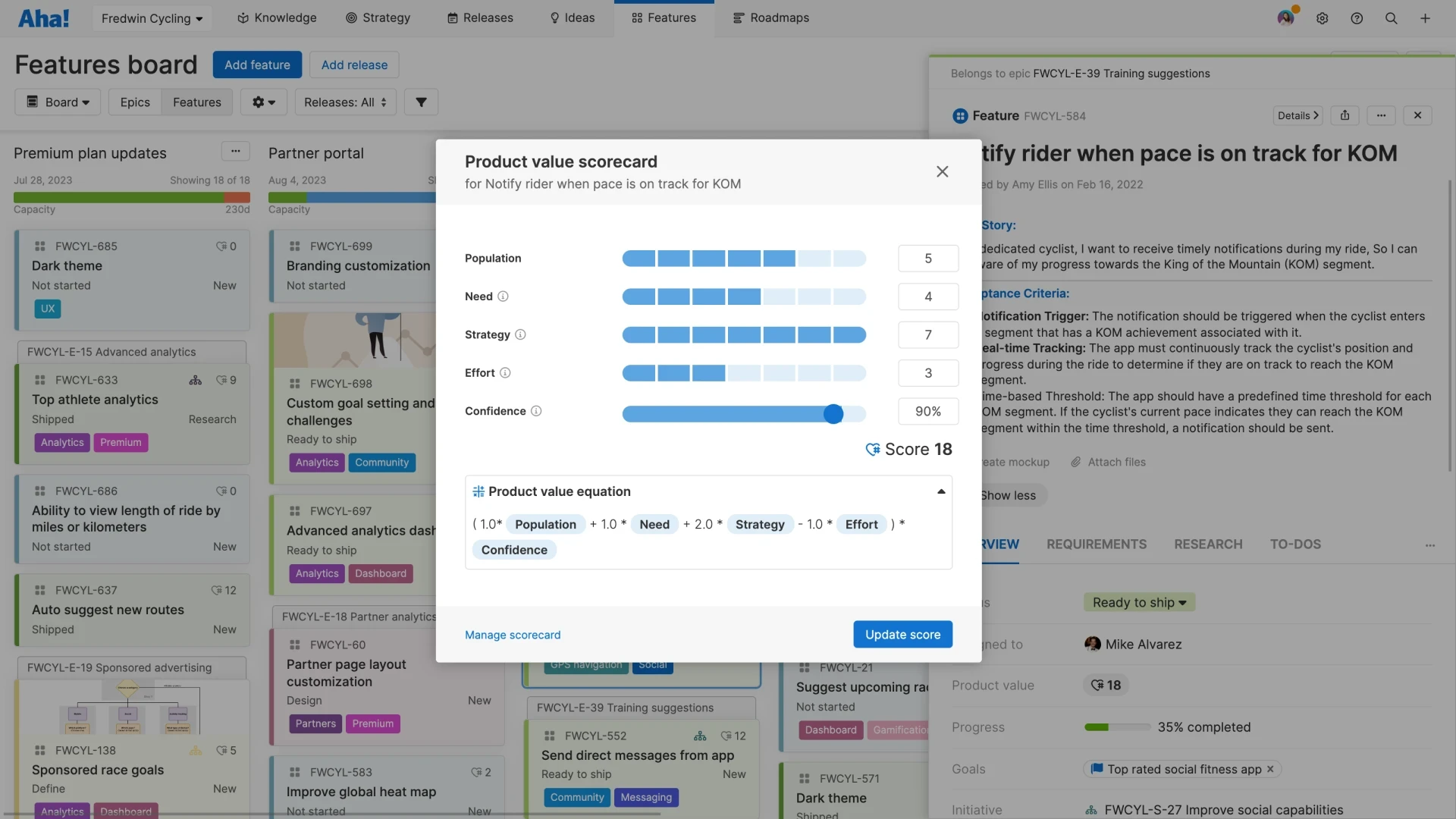How to measure product value
Last updated: August 2024
Every product manager wants to make an impact. The opportunity to turn raw concepts into real products is a rare one — what you build represents the future of the business. And you have the honor of solving problems for people. Colleagues, customers, and your company rely on you to deliver the most value to all. It is a weighty and exciting responsibility.
Value exchange is at the core of most successful products. Yet it can be difficult to understand how to estimate and measure product value. Why? It will actually be different in the eyes of those who build the product and those who use it. For example, a company might see value as the total amount of new revenue generated after a product update. But the user might see value realized in how much time the product saves them each day. Trying to reconcile the varying inputs and find a blended measurement of value is tricky.
The Aha! product value scorecard will change the way you work — see how.
Estimating and measuring product value holistically is essential to business growth. With the emergence of value-based product development, many organizations strive to find the best way to assess value. This guide lays out some of the reasons why product teams are interested in establishing a mechanism for scoring value metrics. We will explore different ways that you can quantify product value throughout the product development lifecycle and the best tools for doing so. Keep reading, or jump ahead to any section:
What is product value and why is it important?
Again, product value means different things to different groups. Some companies simply look at the profit that a product brings the organization: total revenue minus cost to develop. Others view it through core business metrics.
For example, a SaaS company might review how well the product attracts, converts, and retains paying customers. However, looking at product value this way puts the focus on how the product benefits the organization without much regard for the user. Profitability is certainly an important aspect of product value, but it is not the sole measurement.
Others point to specific key performance indicators (KPIs) as a way to measure product value. Understanding product usage data and analytics is a critical part of understanding your product health. But again, it only presents one view of value. Knowing how many people use your product each day or month does not tell you anything about their experience and what they gain by doing so.
Let's shift to a customer perspective. We are all product users. Each of us recognizes value when we experience it. An electric hedge trimmer in place of manual gardening shears saves time. Athletic shoes are the obvious choice for a long walk. Customers choose what they believe will be most effective for solving a specific problem. So value is the benefit we expect to receive while using a product. This includes the value the organization gains, the value the team realizes, and the value the customer perceives.
Measuring product value from idea through to delivery is important because it gives product development teams a way to prioritize based on this holistic view and improve value estimates over time.
Related:
What are value metrics in product development?
Value is subjective. Remember that your measurement will likely comprise more than one metric or source — it depends on your organization, the product you are building, and the market your product serves. It might seem like we are hammering this point, but it is true (and vital to consider!) when choosing value metrics for your product. What works for one organization will not necessarily make sense for another.
If you are a leader in title or action and want to emphasize a value-based approach to product development, here is how you can start:
Get others on board: Set up a meeting with leaders from your product development team to discuss what feels right for your product.
Build your meeting agenda: Draw from your overall company and product strategy to guide the conversation.
Discuss what your customers will value most: During the meeting, try using a virtual whiteboarding tool such as Aha! Whiteboards. In particular, Aha! Whiteboards gives you helpful templates for documenting early-stage thinking with multiple contributors.
One good way to begin crafting your value definition is to look at the elements of a Complete Product Experience: all of the touchpoints that contribute to how people derive value from using your product. Start by listing the interactions that a customer has throughout the lifecycle to understand what ingredients lead to product value (and then a lovable product in the long term).
A business exists to exchange value. This means that the value the product delivers to the company deserves meaningful consideration. Here are a few inward-facing thought starters related to business value. You can use them when crafting a team discussion guide related to product value:
Customers | Business | Market |
|
|
|
How do you measure value as a product manager?
Product managers should estimate and measure value at set intervals. The advantage of creating value scores at specific phases is that the team can look back at the initial estimate to see how close or far off the score was from reality. You will identify opportunities to improve how the team estimates, which will streamline and strengthen decision-making.
Product development expert and Aha! software co-founder Brian de Haaff suggests three checkpoints that most teams should build into their workflows:
Initial value estimate: Early in the idea management process when the concept is raw and not refined
Detailed value estimate: After the effort has been further vetted during roadmap and scoping
Value analysis: What was actually achieved once it is in production and customers use it
You will probably have to update your value estimate a few times throughout the development process as you learn new information. And you might need to do the same for the value analysis, especially if you want to understand the long-term impact of a specific feature.
Because we are human, we want firm answers. Ambiguity is difficult to wade through, and most of us want to feel confident that we are making the right choices. As much as we want to rely on data and analytics to help guide our process, there is an element of the unknowable when you are investing in something new — whether it is an entirely new product or an enhancement to an existing one. This is part of the thrill for product builders.
There is a certain level of gut feeling behind many of the product decisions being made right now. Sure, most teams operate against an overall strategic direction, customer knowledge, and market awareness. Product managers prioritize what they believe to be best based on all of the above.
Creating a value scorecard can help make that decision-making process repeatable. There are a few categories that most product development teams can use to begin estimating product value right away. Each metric should be weighted. (Using a dynamic product value scorecard is helpful here.) Notice that the list below is general and somewhat broad. As you mature how your organization views value, you can narrow in more. For example, you might create a scorecard that includes specific goals or initiatives rather than overall strategic alignment.
Example product value scorecard:
Population: How many customers will this item impact?
Need: How important is it for those who require it?
Strategy: How closely connected is this work to your company and product strategy?
Effort: How much work will it take to build?
Confidence: What is your level of confidence in each score above?
How do you effectively quantify product value?
Value is not static. It constantly evolves based on a variety of factors, from market shifts to customer preferences. So when you think about how your team should quantify product value, it might be tempting to draw up a long list of metrics. But this will create more confusion for the team.
Instead, start with a basic set of metrics. Simpler is better, especially in the beginning. You do not want to overwhelm yourself (or the team) with a complicated formula that relies on many inputs. When you begin to estimate and measure value, you can gradually expand and layer in more data points as analysis matures.
Ideas: Assigning a quick value score as soon as an idea is submitted to the product team can help speed up backlog review meetings.
Features: Value scores should be updated several times as the engineering team begins work and determines the full scope of what you are building.
Releases: Product development software typically includes the ability to dynamically score releases based on the value of all the user stories and features within it.
Realized value is where things get trickier. So far, the product development team is estimating based on its best understanding and the information currently available. But you want to keep everyone honest and close the loop by measuring the actual worth of what was delivered. You can choose a blend of performance metrics here — this will likely be updated over time as more people use what you built. New revenue, add-on revenue, product usage, and customer feedback are all valuable points of reference. Either way, the metrics you choose should be weighted in a way that best reflects your organization's priorities.
Related:
What is the best tool for measuring product value?
Today there are more options than ever for product development teams. Customer feedback, virtual whiteboards, roadmapping, frameworks and development methodologies, and analytics tools proliferate at many organizations. Product development teams can quickly suffer from tool sprawl — and understanding and aligning the mounds of data that come from those tools can be a job itself.
The best tool for measuring product value is a product development software suite that includes everything you need to build and manage products. When all your product data is stored in one system you can more easily track value estimates throughout the development cycle and update realized value scores. Static or scattered tools make this difficult — you might end up spending more time reconciling different inputs instead of analyzing how well the team is doing at driving product value.
Related:
But even if your team is stuck using spreadsheets and email to manage product development, you can still benefit from a value-based approach. Instilling the right mindset and providing the team with standardized templates to work from can help bridge gaps in tooling. This is true whether you follow a prescriptive product development methodology (such as the Scaled Agile Framework®) or a more fluent and adaptable one, (think: scrumban or The Aha! Framework). What matters is that you focus on infusing product value at every phase of the process.




